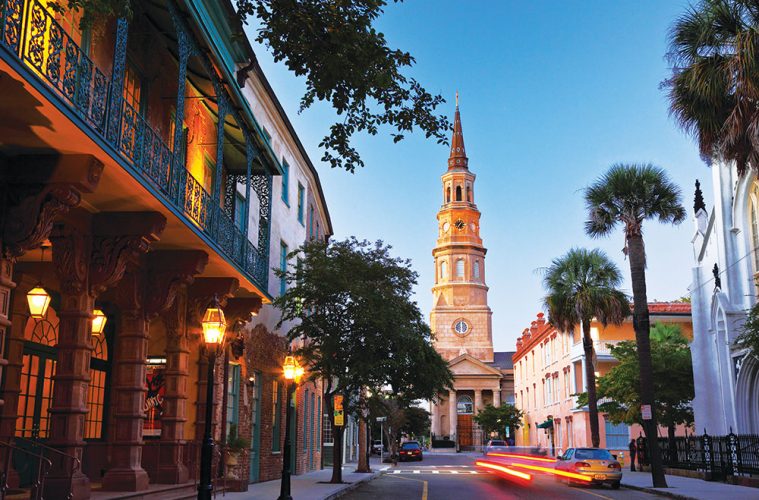Riding a bike on the beach is exhilarating—with the ocean glistening off to one side, the breeze gently pushes you forward across a broad strand of sand. Zigzag to avoid tide pools or splash through them as you see fit.
Cycling in the sand is something few New Englanders would attempt. On Plum Island or at Good Harbor Beach, even the fattest tires would be mired before a pedal or two. Not so on the barrier beaches outside Charleston, South Carolina, where the sand is so tightly packed that a regular cruiser is all that’s required.
Trading in mud season on the North Shore for springtime in Charleston is not necessarily top of mind, but with miles of beaches, a history that goes back to the 1600s, and a hot seafood food scene, New Englanders will find a comfortable familiarity in the city, with an added dose of spice and exotic Southern charm. Not to mention easy access—JetBlue travels there direct from Boston in just about two hours.
Upon arriving, freshen up at the Belmond Charleston Place hotel—its elegant rooftop pool has a retract-able glass ceiling perfect for shed-ding travel stress and adapting to the slower pace south of the Mason-Dixon line. From the fountain out front to the grand double staircase sweeping up from the marble lobby, every touch transports guests to a bygone era—as does the thoughtful service. Book a room on the club floor, recently completely updated as part of a $30-million renovation, and you may not want to leave.
But the city awaits. The historic downtown is picture-book Southern charm, from live oaks dripping with Spanish moss to colorful antebellum homes dotted with wrought iron balconies. The Belmond is centrally located across from the Charleston City Market, one of the oldest public markets in the country. Straddling North and South Market Streets, it is the perfect place to pick up mementos—from stoneground grits and bacon soda (if you dare) to iconic handmade sweetgrass baskets. One of the oldest handcrafts of African origin in the United States, these beautiful baskets are woven from indigenous bulrush by artisans whose ancestors have been crafting them for centuries.
Past the market, head to Waterfront Park to enjoy the famous Pineapple Fountain, a flamboyant ode to that fruity symbol of south-ern hospitality. Stop by around sunset to appreciate it in its fully lit glory, and then wander through the nearby buzzy East Bay section to grab a bite to eat.
It’s easy to spend an enjoyable half-day getting lost in the tiny alleyways and mossy streets of Charleston’s historic district—take in everything from Rainbow Row, a line of 14 Georgian-style homes painted in pastel hues, to the Ed-mondston-Alston House. Facing the High Battery, the city’s waterfront promenade, the home’s lower floors are open for tours, frozen in time in the 1800s, while the top floor is still occupied by a descendant of the Al-stons. For a more formal education, join a horse-drawn carriage tour or stroll with Bulldog Tours. Knowl-edgeable guides are all locals, and can share everything from tales of the Revolutionary War to the home where native son and host of “The Late Show” Stephen Colbert grew up with his 10 siblings.
Grander homes—perhaps with-out the star power—are located just outside downtown. The Charles-ton area is dotted with historic plantations, many of which are involved in the delicate balancing act between celebrating spectacu-lar grounds and lavish homes and recognizing the central role slavery played in that ostentatious wealth.
Middleton Place, about a half hour from downtown Charleston, offers the full plantation experi-ence, from the elegant home that has been in the same family since the 1700s—Arthur Middleton was one of the signers of the Declaration of Independence—to Eliza’s House, a building where freed people lived after slavery was outlawed that now holds a permanent exhibit dedicat-ed to the 2,600 enslaved people that worked at Middleton Place. The eye-opening exhibit includes the prices paid for many of the enslaved, along with stories of their lives as-sembled from historic documents, letters, and archaeological finds. The Beyond the Fields walking tour, included with admission, is not to be missed.
The exotica that Southerners take for granted make for lively food adventures. In fact, the city is a hotbed of creative and classic cookery, rife with award-winning chefs boasting recognition from James Beard and Food & Wine, but just as many are celebrated for old-school Southern home cooking.
Sitting right at the intersection of the two is Husk, the newest offering from James Beard Award–winning chef Sean Brock. Starting with a larder of ingredients indigenous to the South, Brock crafts menus throughout the day, responding to what local purveyors drop by with. Dishes might include everything from johnnycakes topped with pimento cheese to a Bloody Mary made with beet juice and garnished with pickles and ham.
After all that indulging, head out to the Barrier Islands—cruises and kayak tours are available year-round from outfitters like Charles-ton Outdoor Adventures and Barrier Island Eco Tours. Guests are nearly guaranteed to see resident dolphins frolicking just offshore, along with abundant bird life.
Or grab a bike and ride along the beach. Just follow the advice of locals and choose an inland route when you’re riding into the wind—unless you really need to work off that sec-ond serving of johnnycakes.
Belmond Charleston Place

